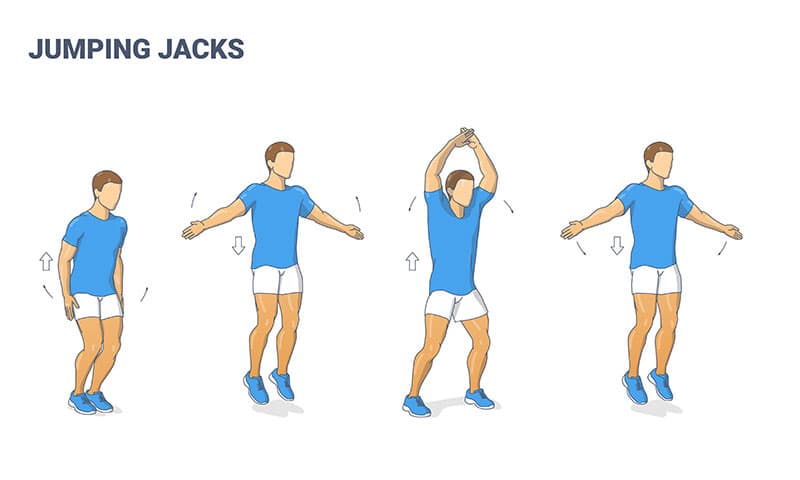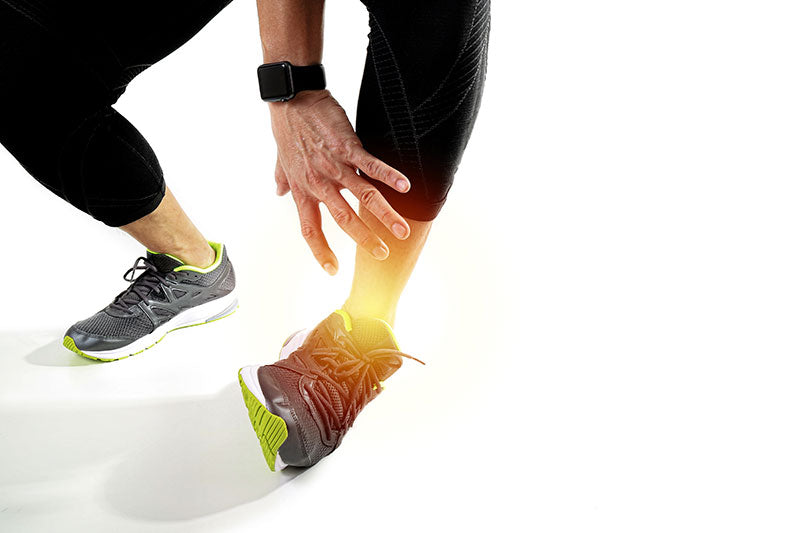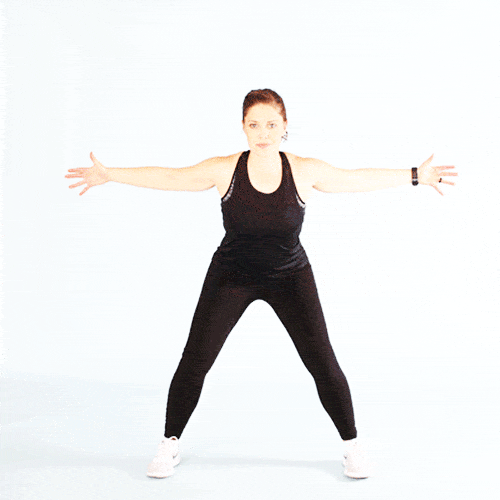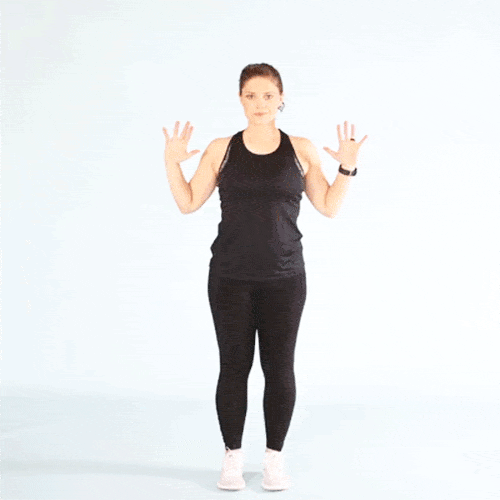We all know that a home workout is essential, but sometimes it can be hard to find the time or motivation to hit the gym. That's where home workouts come in! Home workouts are a great way to get your heart rate up and squeeze in a sweat session without leaving the comfort of your own home.
And jumping jack exercises are one of the best home workout moves you can do. If you're looking for a workout that will get your heart pumping and help you break a sweat, look no further than the jumping jack exercise. This simple yet effective move can be made anywhere, anytime, with no equipment required. Plus, it's a great way to get your blood flowing and your heart rate up.
This home workout guide will show you how to perform jumping jacks exercises correctly to get the most out of them. Let's get started!
How to Do Jumping Jacks

Stand Upright With Your Legs Together, Arms At Your Sides
Jumping jacks require standing upright with your legs and arms at your sides. Then, jump up and spread your legs to the side while bringing your arms up over your head.
Jump back to the starting position and repeat. Keep going for as long as you can or until you're too tired to jump anymore. Just remember: jumping jacks work is not for the faint of heart. A high-intensity exercise will make you sweat, so be prepared to work hard if you want to see results.
Jump Into The Air By Bending Your Knees Slightly
Start by standing with your feet shoulder-width apart and your arms at your sides. Bending your knees slightly and jumping in the air helps you generate more power when you jump and protects your knees from the impact of landing.
Spread your legs as you jump to about twice shoulder-width apart and raise your arms above your head. Spread your legs so that they are shoulder-width apart. Stretch your arms out and over your head.
Jump Back To Starting Position
Reversing the motion when you land and returning to the starting position that's one jumping jack. Depending on your fitness level, you can start with 10 or 20 jumping jacks and work up to more as you get in better shape.
Repeat
As any fitness enthusiast knows, when it comes to working out, there is no such thing as too much of a good thing. And that's why the last step in a jumping jack and workout routine should always be to repeat the entire process until you are thoroughly exhausted.
By pushing your body to its limits, you can ensure you get the most out of your workout and burn the maximum number of calories. So next time you're feeling sluggish during your jumping jacks, remember that the only way to achieve true fitness greatness is to go hard until you can't go any more complicated.
Significant Health Benefits Of Jumping Jacks

Targets The Entire Body
Jump for joy! Or, at the very least, jump for health benefits. That's right - those classic jumping jacks you did as a kid (or maybe still do) are great for your health.
Jumping jacks target full body. They increase your heart rate, which is great for cardio health, and they also work your right and left leg, arms, and core. In other words, they give your whole body a workout in a relatively short amount of time.
Jumping jack is a simple but full body workout yet highly effective body exercise that provides numerous benefits for the whole body. Jumping jacks target almost every muscle group in the body, making them an ideal activity for those looking to improve their overall fitness level. Additionally, jumping jack variations increase the heart rate and can help burn calories and improve cardiovascular health.
And because they are bodyweight exercises, they also help to strengthen bones and reduce the risk of osteoporosis. So, jumping jacks are a great option if you're looking to improve your fitness level or simply want a quick and easy way to get your heart rate up.
Burns fat
Jumping jacks are aerobic exercises that get your heart pumping and your body moving. The simple act of jumping up and down can have significant health benefits, including burning fat. When jumping jacks, your muscles need to work harder to generate the power to jump up and down.
This means that your body is burning calories during a jumping jack workout more than it would if you were just standing still. In addition, jumping helps to increase your heart rate, making it an excellent exercise for your cardiovascular system. So if you're looking for a way to burn fat and get your heart rate up, add some jumping jacks to your workout routine.
Enhances flexibility
One of the best things about jumping jacks is that they provide an excellent workout for your whole body. Not only do they help to improve strength training and endurance during weight training, but they also enhance flexibility. Jumping athletes and fitness enthusiasts often use jumping jacks as a warm-up exercise.
The key to getting the most out of this exercise is to ensure that you land lightly on your feet and keep your knees slightly bent. This will help prevent injury and ensure your muscles are properly stretched.
As you become more comfortable with the exercise, you can increase the intensity by moving your arms more vigorously or adding a jump at the end of each jack. By incorporating jumping jacks into your fitness routine, you can enjoy all the benefits of a full-body workout without going to the gym.
Increases Bone Density
For starters, jumping jacks can help to increase bone density. This is because every time you land after a jump, your bones absorb the impact and become stronger. In addition, jumping jacks can also help to improve balance and coordination.
This is because you are constantly switching positions and using different muscle groups. As a result, jumping jacks are an excellent way to reduce the risk of falls and injuries. So next time you're looking for a quick and easy workout, don't forget about the humble jumping jack!
Mistakes You're Probably Making While Doing Jumping Jacks

Chances are, you've been doing jumping jacks since you were a kid. But just because it's a simple move doesn't mean you're doing it correctly. People make several common mistakes when jumping jacks, which can lead to injuries and ineffective workouts. Here are some of the most common mistakes to avoid:
Not jump high enough: If you're not getting at least six inches off the ground, you're not getting the full benefit of the exercise. Not landing properly
When you land from a jump, your feet should hit the ground simultaneously, with your weight evenly distributed.
Not using arms correctly: Your arms should be fully extended when you jump, and you should clap your hands together overhead when you land.
Not fully extending your arms and legs: When you jump, be sure to stretch your arms and legs fully. This will give you more power and height and help you burn more calories.
Not using your momentum: As you jump up, use your momentum to help you drive your arms up overhead. This will help you generate more power and height with each jump.
Focusing on your feet: It's essential to focus on your whole body when jumping jacks. Concentrating on your feet can cause you to land awkwardly and increase your risk of injury.
Bouncing: When you land, try to stick the landing by absorbing the impact with your legs. Bouncing can put unnecessary stress on your joints and muscles and make it difficult to control your body.
If you're making any of these mistakes, don't worry - they're easy to fix! Remember your form next time you do jumping jacks, and you'll surely get a great workout.
Jumping Jack Adaptations
Squat Jacks

Jumping jacks are a classic bodyweight exercise, but did you know this move has many variations? One variation is the squat jack, also known as the bodyweight squat jump. As the name suggests, this move combines a bodyweight squat with a jump, making it great cardio and leg-strengthening exercise.
To do a squat jack, simply start in a squat position with your feet shoulder-width apart and your hands at your sides. From there, jump up and land with your feet wider than shoulder-width apart. Then, jump again and return to the starting position. Repeat this move for 30 seconds to 1 minute for a challenging workout.
Rotational Jacks

As any fitness enthusiast knows, variety is the key to a good workout. Not only does this help to prevent boredom, but it also allows you to target different muscle groups. One great way to mix up your routine is to try rotational jumping jacks. Start standing with your feet and arms at your sides to do this exercise.
Then, jump up and land with your feet apart and your arms overhead. Next, quickly jump again and rotate your body so that you land with your feet together and your arms at your sides.
Continue alternating between these two positions for a complete set. This exercise may seem simple, but it's pretty challenging. It builds muscle endurance and coordination while also getting your heart rate up.
Low-Impact Rotational Jacks

The jumping jack is a classic full-body workout that has been around for generations. However, traditional exercise can be tough on the joints, particularly the knees. That's why many people are now turning to low-impact rotational jacks, which provide all the original benefits without the risk of joint pain.
To do a low-impact rotational jack, simply stand with your feet shoulder-width apart and your arms at your sides. Then, jump up and rotate your body so your feet land outside your shoulder width.
As you land, bend your knees and hips to absorb the impact. Return to the starting position and repeat. You can also add a twist by reaching your arms overhead as you jump. Not only is this variation great for toning the abs, but it also allows you to get your heart rate up.
Plank jacks

Today, there are many variations of jumping jacks, but the most popular is the plank jack. Plank jacks are performed in a push-up position with arms extended. As you jump, your arms and legs move outward simultaneously. The result is a full-body workout that targets the arms, legs, shoulders, and core.
Plank jacks are an excellent way to increase your heart rate and burn calories. They can also be modified to make them more challenging.
For example, you can add a jump squat or a push-up jack to each rep. Or you can hold dumbbells in each hand to increase the intensity. No matter how you do them, plank jacks are a great way to get your body moving!
Burpees

The burpee is a classic exercise that can be done with or without resistance bands. To do a burpee, start standing with your feet shoulder-width apart. From there, squat down and place your hands on the ground.
Kick your feet back so that you are in a push-up position. Perform a push-up, and then quickly return to the squatting work. Finally, jump up into the air with your hands overhead.
The resistance bands add resistance to the movement, making it more challenging and helping to build muscle. The wide range of motion required for the burpee also makes it an excellent cardio workout. Whether you are looking to get in shape or just want to mix up your workout routine, resistance band burpees are a great option.
Box jumps

To do the box jumps exercise, start by standing in front of a sturdy box or platform at about knee height. Squat down and place your hands on the box, then jump up and land with both feet on top of the box.
From here, you can either jump down from the box or step down slowly (taking care not to let your knees collapse inward). Box jumps are a great bodyweight workout that can help to improve your power, agility, and coordination.
Frequently Asked Questions
How Many Jumping Jacks Should A Beginner Do?
The answer, of course, depends on your fitness level. If you're just starting, you'll want to start with a smaller number of jumping jacks and build up from there. A good rule of thumb is to do one set of 20 jumping jacks, rest for 30 seconds, and then see how you feel. If you're feeling good, you can add a few more sets.
But if you're feeling winded or your muscles are starting to feel fatigued, that's a sign that you should take a break. Remember, the key to any home gym workout is to push yourself at your own pace. So start slow and build up as you go. Soon enough, you'll be doing 100 jumping jacks like it's nothing!
Is It Better To Do Jumping Jacks Fast Or Slow?
The answer may surprise you. Research suggests that it's more effective to do jumping jacks slowly. When you move more slowly, your muscles must work harder to complete the same number of repetitions, resulting in greater muscle activation and a higher calorie burn.
So next time you're looking for a quick workout, don't be afraid to take things slow. Your body will thank you for it.
Do Jumping Jacks Burn Belly Fat?
Though many people believe that jumping jacks is an effective way to burn belly fat, the truth is that jump training is not the most efficient way to target abdominal fat. Combining jump training with a healthy diet and regular cardiovascular exercise is necessary to see results.
Additionally, it is essential to focus on jump training exercises that target the entire body rather than just the abdominals. By doing this, you will be able to benefit from your jump training routine maximally and see results more quickly.
How Do You Make Jumping Jacks Harder?
To make jumping jacks harder, you can either do more sets of jumping jacks or add a challenging twist to the primary move. For example, you can try doing a squat before each jump or adding a side-to-side hop as you bring your arms up and together.
You can also try increasing the height of your jump or adding a small ball at the end of the move. If you want to get creative, you can try doing a one-legged jump jack, alternating legs with each jump. Whatever variation you choose, make sure to challenge yourself so that you continue to see results.
Final Thought On Jumping Jacks As a Home Workout
So there you have it – our complete guide to doing jumping jacks like a pro! If you're looking for an intense, total-body workout that you can do at home with no equipment required, look no further than the jumping jack. Be sure to warm up properly before starting any workout routine, and always listen to your body, modifying as needed.
And if you need more inspiration or guidance on creating a fitness routine that works for you, don't hesitate to subscribe on our newsletter. Check our fitness equipments and accessories that can also help improve your home workouts. We would be happy to help get you started on healthy living.







Hi Team,
i am Ajay from Delhi India...